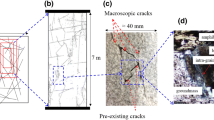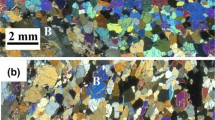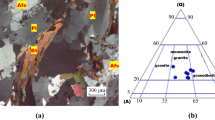Abstract
Rock strength and deformation behavior has long been recognized to be closely related to the microstructure and the associated micro-cracking process. A good understanding of crack initiation and coalescence mechanisms will thus allow us to account for the variation of rock strength and deformation properties from a microscopic view. This paper numerically investigates the micro-cracking behavior of Bukit Timah granite by using a grain-based modeling approach. First, the principles of grain-based model adopted in the two-dimensional Particle Flow Code and the numerical model generation procedure are reviewed. The micro-parameters of the numerical model are then calibrated to match the macro-properties of the rock obtained from tension and compression tests in the laboratory. The simulated rock properties are in good agreement with the laboratory test results with the errors less than ±6%. Finally, the calibrated model is used to study the micro-cracking behavior and the failure modes of the rock under direct tension and under compression with different confining pressures. The results reveal that when the numerical model is loaded in direct tension, only grain boundary tensile cracks are generated, and the simulated macroscopic fracture agrees well with the results obtained in laboratory tests. When the model is loaded in compression, the ratio of grain boundary tensile cracks to grain boundary shear cracks decreases with the increase in confining pressure. In other words, the results show that as the confining pressure increases, the failure mechanism changes from tension to shear. The simulated failure mode of the model changes from splitting to shear as the applied confining pressure gradually increases, which is comparable with that observed in laboratory tests. The grain-based model used in this study thus appears promising for further investigation of microscopic and macroscopic behavior of crystalline rocks under different loading conditions.














Similar content being viewed by others
References
Akesson U, Hansson J, Stigh J (2004) Characterisation of microcracks in the Bohus granite, western Sweden, caused by uniaxial cyclic loading. Eng Geol 72(1–2):131–142
Bahrani N, Kaiser PK (2016) Numerical investigation of the influence of specimen size on the unconfined strength of defected rocks. Comput Geotech 77:56–67
Bahrani N, Potyondy D, Pierce M (2012) Simulation of Brazilian test using PFC2D grain-based model. In: Proceedings of 21st Canadian rock mechanics symposium, Edmonton, Canada, pp 485–493
Bahrani N, Kaiser PK, Valley B (2014) Distinct element method simulation of an analogue for a highly interlocked, non-persistently jointed rock mass. Int J Rock Mech Min Sci 71:117–130
Bass DJ (1995) Elasticity of minerals, glasses, and melts. In: Ahrens TJ (ed) Mineral physics & crystallography: a handbook of physical constants. American Geophysical Union, Washington, D. C., pp 45–63
Batzle ML, Simmons G, Siegfried RW (1980) Microcrack closure in rocks under stress—direct observation. J Geophys Res 85(Nb12):7072–7090
Bewick RP, Kaiser PK, Bawden WF, Bahrani N (2014a) DEM simulation of direct shear: 1. Rupture under constant normal stress boundary conditions. Rock Mech Rock Eng 47(5):1647–1671
Bewick RP, Kaiser PK, Bawden WF (2014b) DEM simulation of direct shear: 2. Grain boundary and mineral grain strength component influence on shear rupture. Rock Mech Rock Eng 47(5):1673–1692
Bieniawski ZT (1967) Mechanism of brittle fracture of rock. Int J Rock Mech Min Sci Geomech Abstr 4(4):395–430
Brace WF, Paulding B, Scholz C (1966) Dilatancy in the fracture of crystalline rocks. J Geophys Res 71:3939–3953
Cai M, Kaiser PK, Tasaka Y, Maejima T, Morioka H, Minami M (2004) Generalized crack initiation and crack damage stress thresholds of brittle rock masses near underground excavations. Int J Rock Mech Min Sci 41(5):833–847
Cao R, Cao P, Lin H, Pu C, Ou K (2016) Mechanical behavior of brittle rock-like specimens with pre-existing fissures under uniaxial loading: experimental studies and particle mechanics approach. Rock Mech Rock Eng 49(3):763–783
Chen Y (2008) Observation of microcracks patterns in Westerly granite specimens stressed immediately before failure by uniaxial compression loading. Chin J Rock Mech Eng 27(12):2440–2448
Chen Y, Nishiyama T, Kusuda H, Kita H, Sato T (1999) Correlation between microcrack distribution patterns and granitic rock splitting planes. Int J Rock Mech Min Sci 36(4):535–541
Cheng Y, Wong LNY, Maruvanchery V (2016) Transgranular crack nucleation in Carrara marble. Rock Mech Rock Eng 49(8):3069–3082
Cho N, Martin CD, Sego DC (2007) A clumped particle model for rock. Int J Rock Mech Min Sci 44:997–1010
Cundall PA (1971) A computer model for simulating progressive, large scale movements in blocky rock systems. In: Proceedings of the international symposium on rock fracture, Nancy, pp 129–136
Diederichs MS (1999) Instability of hard rock masses: the role of tensile damage and relaxation. PhD thesis. University of Waterloo, p 617
Diederichs MS (2007) The 2003 Canadian geotechnical colloquium: mechanistic interpretation and practical application of damage and spalling prediction criteria for deep tunneling. Can Geotech J 44(9):1082–1116
Diederichs MS, Kaiser PK, Eberhardt E (2004) Damage initiation and propagation in hard rock during tunnelling and the influence of near-face stress rotation. Int J Rock Mech Min Sci 41(5):785–812
Dwivedi RD, Goel RK, Prasad VVR, Sinha A (2008) Thermo-mechanical properties of Indian and other granites. Int J Rock Mech Min Sci 45(3):303–315
Eberhardt E, Stead D, Stimpson B, Read RS (1998) Identifying crack initiation and propagation thresholds in brittle rock. Can Geotech J 35(2):222–233
Erarslan N, Williams DJ (2012) Investigating the effect of cyclic loading on the indirect tensile strength of rocks. Rock Mech Rock Eng 45(3):327–340
Fairhurst CE, Hudson JA (1999) Draft ISRM suggested method for the complete stress–strain curve for intact rock in uniaxial compression. Int J Rock Mech Min Sci 36(3):279–289
Fakhimi A, Villegas T (2007) Application of dimensional analysis in calibration of a discrete element model for rock deformation and fracture. Rock Mech Rock Eng 40(2):193–211
Fredrich JT, Wong TF (1986) Micromechanics of thermally induced cracking in three crustal rocks. J Geophys Res 91(B12):12743–12764
Geraud Y, Mazerolle F, Raynaud S, Lebon P (1998) Crack location in granitic samples submitted to heating, low confining pressure and axial loading. Geophys J Int 133(3):553–567
He MC, Miao JL, Feng JL (2010) Rock burst process of limestone and its acoustic emission characteristics under true-triaxial unloading conditions. Int J Rock Mech Min Sci 47(2):286–298
Hofmann H, Babadagli T, Yoon JS, Zang A, Zimmermann G (2015a) A grain based modeling study of mineralogical factors affecting strength, elastic behavior and micro fracture development during compression tests in granites. Eng Fract Mech 147:261–275
Hofmann H, Babadagli T, Zimmermann G (2015b) A grain based modeling study of fracture branching during compression tests in granites. Int J Rock Mech Min Sci 77:152–162
Homand-Etienne F, Houpert R (1989) Thermally induced microcracking in granites: characterization and analysis. Int J Rock Mech Min Sci Geomech Abstr 26(2):125–134
Inserra C, Biwa S, Chen Y (2013) Influence of thermal damage on linear and nonlinear acoustic properties of granite. Int J Rock Mech Min Sci 62(6):96–104
Itasca Consulting Group Inc. (2008a) Particle Flow Code in 2 dimensions (PFC2D), Version 4.0. Minneapolis
Itasca Consulting Group Inc. (2008b) Particle Flow Code in 3 dimensions (PFC3D), Version 4.0. Minneapolis
Ivars DM, Pierce ME, Darcel C, Reyes-Montes J, Potyondy DO, Young RP, Cundall PA (2011) The synthetic rock mass approach for jointed rock mass modelling. Int J Rock Mech Min Sci 48(2):219–244
Jansen DP, Carlson SR, Young RP, Hutchins DA (1993) Ultrasonic imaging and acoustic emission monitoring of thermally induced microcracks in Lac du Bonnet granite. J Geophys Res Solid Earth 98(B12):22231–22243
Jones C, Keaney G, Meredith P, Murrell SAF (1997) Acoustic emission and fluid permeability measurements on thermally cracked rocks. Phys Chem Earth 22(1):13–17
Kawakata H, Cho A, Yanagidani T, Shimada M (1997) The observations of faulting in Westerly granite under triaxial compression by X-ray CT scan. Int J Rock Mech Min Sci 34(3):1–12
Kazerani T, Zhao J (2010) Micromechanical parameters in bonded particle method for modelling of brittle material failure. Int J Numer Anal Meth Geomech 34(18):1877–1895
Kumruzzaman M, Yin JH (2012) Stress–strain behaviour of completely decomposed granite in both triaxial and plane strain conditions. Jordan J Civil Eng 6(1):83–110
Labuz JF, Dai ST, Papamichos E (1996) Plane–strain compression of rock-like materials. Int J Rock Mech Min Sci Geomech Abstr 33(6):573–584
Lajtai EZ, Lajtai VN (1974) The evolution of brittle fracture in rocks. J Geolog Soc 130(1):1–16
Lan HX, Martin CD, Hu B (2010) Effect of heterogeneity of brittle rock on micromechanical extensile behavior during compression loading. J Geophys Res Solid Earth. doi:10.1029/2009jb006496
Lei XL, Kusunose K, Nishizawa O, Cho A, Satoh T (2000) On the spatio-temporal distribution of acoustic emissions in two granitic rocks under triaxial compression: the role of pre-existing cracks. Geophys Res Lett 27(13):1997–2000
Li HB, Zhao J, Li TJ (1999) Triaxial compression tests on a granite at different strain rates and confining pressures. Int J Rock Mech Min Sci 36(8):1057–1063
Lim SS, Martin CD, Akesson U (2012) In-situ stress and microcracking in granite cores with depth. Eng Geol 147–148:1–13
Liu T, Lin B, Zou Q, Zhu C, Guo C, Li J (2015) Investigation on mechanical properties and damage evolution of coal after hydraulic slotting. J Nat Gas Sci Eng 24:489–499
Luque A, Ruiz-Agudo E, Cultrone G, Sebastian E, Siegesmund S (2011) Direct observation of microcrack development in marble caused by thermal weathering. Environ Earth Sci 62(7):1375–1386
Martin CD, Chandler NA (1994) The progressive fracture of Lac du Bonnet granite. Int J Rock Mech Min Sci Geomech Abstr 31(6):643–659
Nasseri MHB, Schubnel A, Young R (2007) Coupled evolutions of fracture toughness and elastic wave velocities at high crack density in thermally treated Westerly granite. Int J Rock Mech Min Sci 44(4):601–616
Nishiyama T, Kusuda H (1994) Identification of pore spaces and microcracks using fluorescent resins. Int J Rock Mech Min Sci Geomech Abstr 31(4):369–375
Nishiyama T, Chen YQ, Kusuda H, Ito T, Kaneko K, Kita H, Sato T (2002) The examination of fracturing process subjected to triaxial compression test in Inada granite. Eng Geol 66(3–4):257–269
Paterson MS (1958) Experimental deformation and faulting in Wombeyan marble. Geol Soc Am Bull 69(4):465–476
Peng R, Ju Y, Wang JG, Xie H, Gao F, Mao L (2015) Energy dissipation and release during coal failure under conventional triaxial compression. Rock Mech Rock Eng 48(2):509–526
Peng J, Wong LNY, Teh CI (2017) Influence of grain size heterogeneity on strength and micro-cracking behavior of crystalline rocks. J Geophys Res Solid Earth 122(2):1054–1073
Potyondy DO (2010) A grain-based model for rock: approaching the true microstructure. In: Proceedings of the rock mechanics in the Nordic Countries, Kongsberg, Norway
Potyondy D, Cundall P (2004) A bonded-particle model for rock. Int J Rock Mech Min Sci 41(8):1329–1364
Ren J, Ge X (2004) Computerized tomography examination of damage tests on rocks under triaxial compression. Rock Mech Rock Eng 37(1):83–93
Sufian A, Russell AR (2013) Microstructural pore changes and energy dissipation in Gosford sandstone during pre-failure loading using X-ray CT. Int J Rock Mech Min Sci 57:119–131
Tapponnier P, Brace WF (1976) Development of stress-induced microcracks in Westerly granite. Int J Rock Mech Min Sci Geomech Abstr 13:103–112
Vinegar HJ, Dewaal JA, Wellington SL (1991) CT studies of brittle failure in Castlegate sandstone. Int J Rock Mech Min Sci Geomech Abstr 28(5):441–448
Wawersik W, Fairhurst C (1970) A study of brittle rock fracture in laboratory compression experiments. Int J Rock Mech Min Sci Geomech Abstr 7(5):561–575
Weng MC, Li HH (2012) Relationship between the deformation characteristics and microscopic properties of sandstone explored by the bonded-particle model. Int J Rock Mech Min Sci 56:34–43
Wong TF (1982) Micromechanics of faulting in Westerly granite. Int J Rock Mech Min Sci 19(2):49–64
Wong LNY, Einstein HH (2009) Crack coalescence in molded gypsum and Carrara marble: part 2—microscopic observations and interpretation. Rock Mech Rock Eng 42(3):513–545
Wong LNY, Maruvanchery V (2016) Different lithological varieties of Bukit Timah granite in Singapore: a preliminary comparison study on engineering properties. Rock Mech Rock Eng 49(7):2923–2935
Yang SQ, Huang YH, Jing HW, Liu XR (2014) Discrete element modeling on fracture coalescence behavior of red sandstone containing two unparallel fissures under uniaxial compression. Eng Geol 178:28–48
Yong C, Wang C (1980) Thermally induced acoustic emission in Westerly granite. Geophys Res Lett 7(12):1089–1092
Yoon J (2007) Application of experimental design and optimization to PFC model calibration in uniaxial compression simulation. Int J Rock Mech Min Sci 44(6):871–889
Yumlu M, Ozbay MU (1995) A study of the behaviour of brittle rocks under plane strain and triaxial loading conditions. Int J Rock Mech Min Sci Geomech Abstr 32(7):725–733
Zhang XP, Wong LNY (2012) Cracking processes in rock-like material containing a single flaw under uniaxial compression: a numerical study based on parallel bonded-particle model approach. Rock Mech Rock Eng 45(5):711–737
Zhang XP, Wong LNY (2013) Crack initiation, propagation and coalescence in rock-like material containing two flaws: a numerical study based on bonded-particle model approach. Rock Mech Rock Eng 46(5):1001–1021
Zhang XP, Wong LNY (2014) Displacement field analysis for cracking processes in bonded-particle model. Bull Eng Geol Environ 73:13–21
Zhang XP, Liu Q, Wu S, Tang X (2015) Crack coalescence between two non-parallel flaws in rock-like material under uniaxial compression. Eng Geol 199:74–90
Zhao J (1996) Construction and utilization of rock caverns in Singapore Part A: the Bukit Timah granite bedrock resource. Tunn Undergr Space Technol 11(1):65–72
Zhao J (1998) Rock mass hydraulic conductivity of the Bukit Timah granite, Singapore. Eng Geol 50(1):211–216
Zhao J (1999) Strength and deformation characteristics of the Bukit Timah granite under static and dynamic compression, Academic Research Project RG 21/94. School of Civil and Structural Engineering, Nanyang Technological University, Singapore
Zhao J, Broms B, Zhou Y, Choa V (1994a) A study of the weathering of the Bukit Timah granite part A: review, field observations and geophysical survey. Bull Int Assoc Eng Geol 49(1):97–106
Zhao J, Broms B, Zhou Y, Choa V (1994b) A study of the weathering of the Bukit Timah granite Part B: field and laboratory investigations. Bull Int Assoc Eng Geol 50(1):105–111
Zhao J, Zhou Y, Sun J, Low B, Choa V (1995) Engineering geology of the Bukit Timah Granite for cavern construction in Singapore. Q J Eng Geol Hydrogeol 28(2):153–162
Zhao XG, Cai M, Wang J, Ma LK (2013) Damage stress and acoustic emission characteristics of the Beishan granite. Int J Rock Mech Min Sci 64:258–269
Zhao XG, Cai M, Wang J, Li PF (2015) Strength comparison between cylindrical and prism specimens of Beishan granite under uniaxial compression. Int J Rock Mech Min Sci 76:10–17
Acknowledgements
The authors thank Mr. Varun Maruvanchery at Nanyang Technological University for kindly providing photographs showing the failure modes of rock specimens under uniaxial compression. The support from the Singapore Academic Research Fund Tier 1 Grant (RG112/14) is gratefully acknowledged. The first author acknowledges the support from the National Natural Science Foundation of China (Grant No. 51609178), the China Postdoctoral Science Foundation (Grant No. 2015M582273), and the Fundamental Research Funds for the Central Universities (Grant No. 2042016kf0042). The first and second authors also acknowledge the support from the Seed Funding Program for Basic Research for New Staff at the University of Hong Kong, and the General Research Fund of the Research Grants Council (Hong Kong).
Author information
Authors and Affiliations
Corresponding author
Rights and permissions
About this article
Cite this article
Peng, J., Wong, L.N.Y., Teh, C.I. et al. Modeling Micro-cracking Behavior of Bukit Timah Granite Using Grain-Based Model. Rock Mech Rock Eng 51, 135–154 (2018). https://doi.org/10.1007/s00603-017-1316-x
Received:
Accepted:
Published:
Issue Date:
DOI: https://doi.org/10.1007/s00603-017-1316-x




